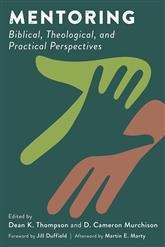formation
Select an item by clicking its checkbox
When teaching on issues of social justice, a faculty’s posture can foster or impede the students’ ability to learn and engage fully in the process. I teach Biblical Interpretation. One of the favorite courses that I have designed and taught is “Hermeneutics for Ministry”. This is a graduate course ...
Students are always already being "formed" in our online classes, whether we mean to have incorporated "formation" into our course designs or not. In this ineluctable process of formation, do the communities of inquiry designed into our online classes align with the norms and values of the communities into which ...

Mentoring: Biblical, Theological, and Practical Perspectives
Date Reviewed: December 13, 2018
In Mentoring: Biblical, Theological, and Practical Perspectives, Thompson and Murchison provide a thoughtful collection of essays on Christian mentorship. As a whole, this collection contributes to the growing body of scholarly work on mentoring by offering “windows on mentoring that are biblically grounded, theologically informed, communally diverse, and generationally attentive” (3). The book is divided into four parts, with each of the fourteen chapters highlighting the twenty-one contributors’ unique analyses and insights on mentoring and being mentored.
Part 1 surveys biblical perspectives on mentoring. As such, it begins with Brueggemann’s consideration of mentoring practices present throughout the Old Testament and concludes with a posthumous essay by Bartlett on passages in the New Testament that help to shed light on contemporary understandings of the term “mentor.”
Part 2 examines the nature and task of mentoring from a variety of theological perspectives and methods. Drawing on the fields of pastoral ministry (Currie), homiletics (Long), ethics (Miles), and feminism (Rigby), the authors provide a range of mentoring models and resources that underscore the importance of positive mentoring relationships and practices in the formation of strong Christian leaders. On this Rebekah Miles writes, “Christian mentoring should include discussion of the ways that our professional goals contribute to the larger goals of Christian life” (83).
Part 3, “Diverse National and International Communities of Mentoring,” explores Christian mentoring practices as shaped by particular contexts, including race, gender, and ethnicity. Those who wish to think critically about dominant systems of oppression, such as racism, xenophobia, and sexism, and to foster concrete practices for inclusive mentoring within biblical-theological frameworks will find a wealth of resources in the essays by Pollard, Cannon, De La Rosa, and Kwok. Of particular note is Canon’s proposal that womanist mentoring is a vocational call, “to do the work your soul must have” (123). This section also includes an historical essay by Johnson on mentoring in the Roman Catholic tradition.
Finally, Part 4 contains three coauthored chapters that discuss mentoring as a mutually supportive practice that occurs across generations. Ottati and Hinson-Hasty’s essay, “Mentoring toward a Humane Disposition, Attitude, and Imagination,” describes mentoring relationships between the teachers and student, while Nishioka and Lowry and Wardlaw and Murray’s essays consider youth and cross-generational mentoring, respectively
The book closes with an afterword by Marty that skillfully and poetically weaves together the insights and value of this collection of essays. He writes, “It is impossible to speak properly about mentoring in entirely impersonal and theoretical terms. Mentoring is and is about a profound personal dimension of scholarly and pastoral work” (223).
Those working in theological schools or departments and in Christian ministry will find this collection of essays to be a valuable resource on the virtue and art of mentoring. The strength of this volume lies not only in its biblical and theological reflections on mentoring, but also in the range of everyday lived experiences and perspectives from which the authors write.

Leave Your Attitude at the Door: Dispositions and Field Experiences in Education
Date Reviewed: September 13, 2017
If a title reflects a book’s content, then this work is a particularly good case in point. The authors consistently refer to various real-life examples from the sphere of education in order to highlight the importance of attitudes and dispositions. While thus staying true to the book’s title, the authors additionally share pieces of wisdom from the field informed by years of experience.
Education is a service industry. Educators and trainees are called to serve and not to be served. While this may seem like commonsense, the authors remind readers that commonsense is not all that common and the problem of entitlement is not as uncommon as one would like it to be (26). In this light, the authors make the case for the assessment of dispositions along with accompanying narratives that will address the issue in a professional and timely manner (38). While offering critical feedback, however, coordinators and instructors are simultaneously encouraged to keep in mind the need for reassurance, support, and empathy for students who are teacher candidates.
The book is filled with humor, allowing readers to let their guards down a little and see the need for inculcating professionalism in work settings. The authors narrate accounts of students in training who cite seemingly legitimate reasons for absences only to be caught – thanks to social media – going on cruises. The authors offer other cases, such as those who try to outmaneuver school buses pulling out of parking lots just to get ahead. Then, believe it or not, are those who speak inappropriately to students, including saying, “You don’t like my jacket? Well, your momma liked it last night” (42).
Working with future educators, the authors argue rightly, necessitates being proactive. While entitlement and lack of professionalism are matters of utmost concern when working with teacher candidates who are adults, these very adults also have particular lives that bring up questions of shelter, work-school balance, adequate food, parenting and other familial responsibilities. “Can you be proactive? Yes! Should you be proactive? Yes! Does it take time? Yes! Does it take work? Yes! Is it worth it? Absolutely!” (47). Through such series of questions and responses, the book presents a wealth of material in a readily accessible manner to teacher educators.
Educators are warned that perfectionism may come at the cost of unsustainable superficiality. Reminding educators that “we are they,” the authors note that “what we create together will ultimately serve our students, schools, and communities” (55). The emphasis on creating together means that authentic, professional, and healthy relationships and partnerships are acknowledged as being at the heart of a successful field education experience (55). Such relationships and partnerships need constant tending and care, much like a garden (54-55).
As readers make their way through the book, a realization soon emerges. Transcending the this-is-my-obligation attitude in order to come to a place where “we make promises and keep them” (59) is key. Commitment, talent, and care for the educational setting are tested by problems, dispositions, and attitudes (77). Anyone interested in navigating these realities would benefit from engaging this work.

How Youth Ministry Can Change Theological Education - If We Let It
Date Reviewed: March 29, 2017
Acutely aware of the North American religious landscape, the editors introduce the volume by noting two ironies – a vast majority of young people subscribe to a superficial understanding of self, God, and the world, and those who are more complexly informed are often mistakenly considered by youth ministries to be “already won” (8). With this awareness, the editors bring together a diverse set of essays that intentionally make an effort to overcome this irony. By making critical references to High School Theology Programs, the different authors weigh in on the matter by treating high school students as full persons who desire and invite serious mentorship, challenge conventionally held notions, and are ready to hit the spiritual formation ball out of the park.
Several authors highlight how young people are often liturgically formed by dominant social conventions that impact their behavior and their ability to articulate the meaning of self and world. If young people are thus culturally tutored, how can those in youth ministry enable a different way of theologically framing lived experiences? How can they creatively disrupt unhelpful naming systems, for example, that young people are enculturated into in such a way that naming the issue could become a means to rethink and rename ways of being in the world? What would this take and what would it cost?
Each author presents arguments and perspectival interventions that are based on hard evidence and long-term work with high school students. Work with youth, in the end, affects youth and those who work with them. The book argues that such giving and receiving offers grounds for holy friendship and mutual companionship that can and will positively change self and world. Faculty members in theological schools are encouraged to actively seek out for themselves and others opportunities to teach age groups that they may not otherwise readily engage. No age is “too young.” While the difficulty of the task is not underestimated, the rewards, the authors argue, are many. Church workers are called to focus not so much on saving churches but rather on “saving lives” (275). Both may eventually be saved in the process.
The subtitle “If We Let It” captures the philosophical framework of this book. Readers interested in learning how youth ministry can change theological education – if we let it – will learn a great deal from this work that serves as a well-researched handbook, an indictment of theological malnourishment, and a mirror that poses hard and important questions to those interested in more than a cosmetic makeover of theological education today.

